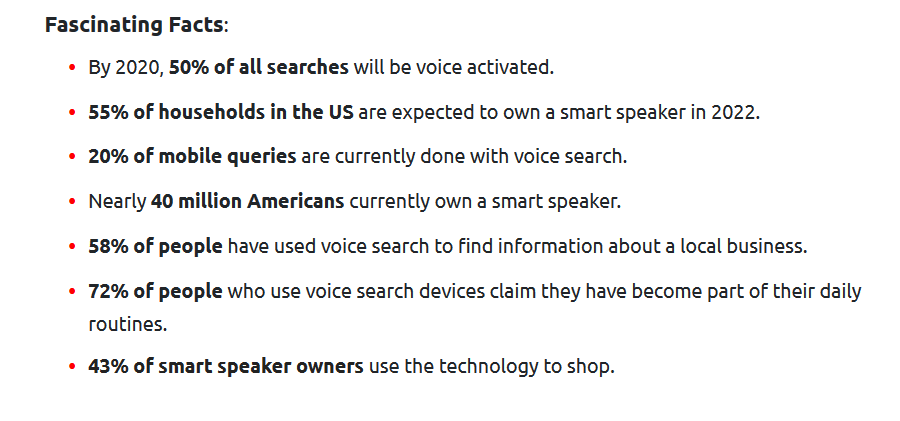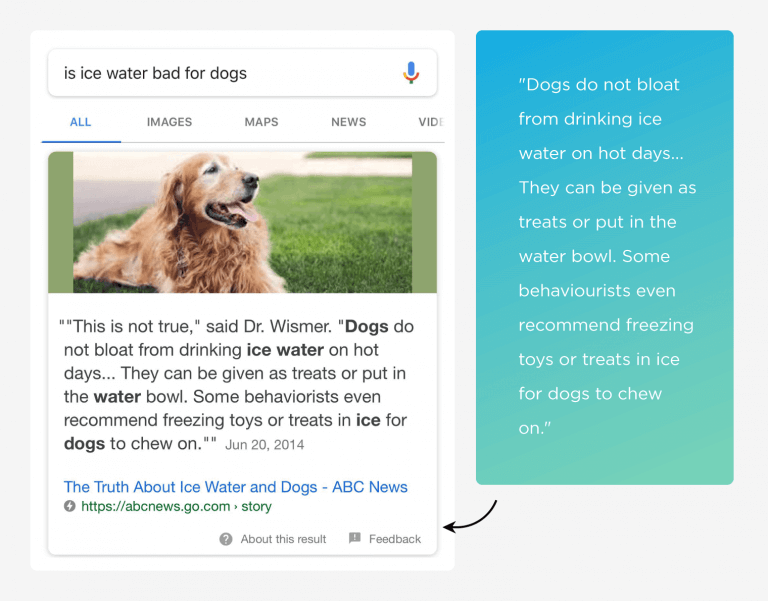Did you know every month there are one billion searches made by voice? Have you done voice search optimization for your website? That’s what you’re going to learn here in this definitive guide on voice search optimization.

Source: Pinterest
We’re now living in a world where it’s possible to search for information on the internet using our voices.
It’s something that no one ever thought would be possible, but now it’s here, and it’s become a part of people’s way of living. Thanks to technological advancements in the recent decade, many have realized the potential of voice search.
Here are some stats about voice search optimization:

Source: review42
Voice search’s rise to prominence continues to make an impact on the online searching behavior of people. The status of keywords changed because instead of typing, people use voice assistants to find stuff online.
The current situation now prompts websites, especially e-commerce businesses, to optimize their online assets for voice search.
The process of searching online became straight to the point, which is more convenient for many consumers. As a website owner, you need to adapt, so your website remains relevant by appearing in voice search results. That’s what you’re going to learn here in this definitive guide on voice search optimization.
Optimizing content for voice search
Voice assistants answer search queries by finding online content that matches them. This means that your content needs to match keywords that users are asking. Here are a few simple ways to tweak your website’s content for voice search optimization:
#1 Include concise answers
Backlinko analyzed voice search results from Google Home, and here’s what they found out: Google has a tendency to answer voice search queries with 29-word results, which is a concise length in terms of search results. Y
ou can see its answer to the question: “are figs good for you?” on the image below:

Image source: Backlinko
Google Home gave answered the question with 28 words. Therefore, your content must answer these types of questions with 30 words or less.
#2 Create FAQ pages
Using frequently asked questions or FAQs helps immensely in optimizing your website content for voice search.
It fits a couple of factors in voice search optimization, the first one being it provides concise answers to questions, and the next is because question keywords have increased due to voice search.
According to Backlinko’s Google Home study results, voice search results come from FAQ pages 1.7x more than desktop results.
It means that FAQ pages have a higher potential for ranking in thousands of voice search queries because people that use voice search use “who,” “what,” “when,” “where,” “how,” and “which” to find the information that they need.
Keywords are becoming more specific and to the point because of voice search. In fact, question keywords grow 61% year-over-year because of it.
Depending on how popular voice search gets, there may come a time when you won’t need to consider short one or two-word long keywords for search engine optimization (SEO).
#3 Use long-tail keywords
Long-tail keywords are phrases or sentences that point users to the information they’re searching for.
These keywords provide more refined results that can help e-commerce websites connect with their target audience effectively. You can use long-tail keywords by placing them on any of your long-form content.
Google pulls up concise answers even if they’re found way below the content page. It finds keywords included on the user’s question search and looks for the best answer it can find containing those keywords on your site’s content.
It disregards its position on the page and how much portion it covers as long as it has the most appropriate answer to the voice search query.
Aside from creating an FAQ page, you can also use Rank Watch’s “get keyword ideas” search for using long tail keywords.
#4 Write content with natural language
You’ll need to write content that voice assistants can understand to optimize your content for voice search.
As aforementioned, voice search queries are preceded by a precise set of instructions (who, what, where, when, how, etc.). Thus, your content has to be more conversational in approach.
Write more natural, conversational content since users use words they usually use in conversations when they voice search.
Distance yourself from robotic keyboard search words so that your content will be easier to understand in voice search standards. Speak the language of voice search, and it’ll understand you.
Here are some tips that can help you format your content to sync it to voice search engines:
- Create or update your content in a more conversation-like manner.
- Avoid keywords that you can’t explain.
- Use question phrases and provide answers to them.
#5 Rank in featured snippets with voice search optimization
Your content should rank in featured snippets so that voice assistants will pick them. 40.7% of answers from voice search come from the featured snippets. Ranking on those will help your content be more visible to Alexa or Google Home.
Featured snippets are selected search results displayed in a box on top of Google’s organic results below the ads.
They’re also known as “answer boxes” because their aim is to answer user questions quickly. These answer boxes usually display high-quality content providing in-depth answers to questions.
Here’s what you’ll get if you voice search: “Is ice water bad for dogs?” on your Google iPhone app:

Image source: Backlinko
Remember those voice assistants such as Google Home, Alexa, and Siri only give you one answer. Optimizing your content to get on the featured snippet puts your pages at a higher chance to be chosen by those assistants as the answer for user voice search.
Responsive website design
Having a responsive design is also important for optimizing your website for voice search.
It’s because voice search optimization is attributed as a byproduct of smartphone technology, enabling users to use voice search on your website or include your content as a possible voice search result. Thus, your website has to be compatible with multiple platforms.
Voice search engine tools favor websites with responsive designs because they also rank higher on search engine results.
Concerning this, you also have to improve your site’s loading speed because it’s also key to boosting your search engine results ranking. Also, the loading speed of a voice search result is more than 3x faster than the average website.
Optimize your site for the “near me” keyword
Precise words are always included in voice search queries. One category of keywords that tend to be included in a voice search is location.
“Where can I find a diner near me?” “Where is the nearest local bar?” These are typical questions inquiring about precise locations using voice search.
Hence, it only makes sense to have your website optimized for “near me” questions. Make sure that your pages have been optimized for local search so you can capitalize on voice searches.
If you haven’t done this, these are the steps you need to accomplish to have your website locally optimized on search engines:
#1 Setup your Google My Business Page
The first thing you have to do is to make your Google My Business page. Make sure to do the following:
- A proper and unique description of your business, including links
- Select the right categories that define your business
- Include a local number to your listings
- Include your business address that’s posted on your website and local directories (if there are any)
- Upload photos
#2 Name, Address, and Place (NAP)
Be consistent and include the full NAP details of your business across your website’s pages. You should also use the same details in other website citations.
#3 Local Reviews
Local reviews from local customers should be included on your website to boost your local search rankings. You can also use local directory pages like Yelp to help in optimizing your website for local search results.
Optimize your videos with voice search optimization
Google also includes videos as part of search results. It tailors user search results by showing a video from a website relevant to the user’s query and indicates which parts of the video have relevant information regarding the keywords used.
Data from Bing shows that video results appear more often for natural language queries, which is what people use for voice search. If you ask your voice assistant: “How do I rank my YouTube videos?” this is what you’ll see:

Image source: Backlinko
Rank your videos so you can jump to the top of search results on voice search as well.
Include filler words on question keywords
Since the increase in question keywords is driven by the rise in voice search, you have to optimize question keywords on your content.
One of the best ways to do that is including filler words like “a,” “me,” and “for” with them. For example, “What are foods that I can eat for a healthy diet?’
Your pages will match more voice search like that if you include filler words.
Key takeaways
To optimize your website for voice search, you have to focus on your website, content, and other essential details for ranking on search results. For your content, you need to use question keywords to speak the language of voice search users.
Voice search is concentrated more on natural language; thus, using long-tail keywords, creating FAQ pages, targeting question keywords by including filler words, and writing in a conversational tone will be recognized more.
Other factors, such as having a responsive design, optimizing your videos, and local search optimization, also help. The best thing is, these are only simple changes, which means it won’t be necessary to overhaul anything.
Conclusion
Voice search is defining the future of SEO. Its already futuristic appeal has gotten it to where it is now, and it may not stop gaining steam. Embrace it and adapt so your business can stay with the times.





1 Comment